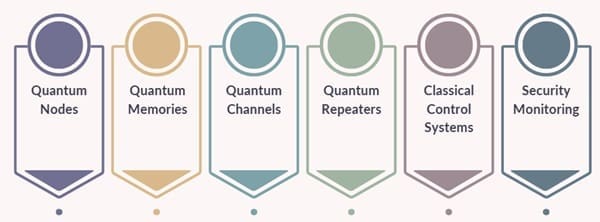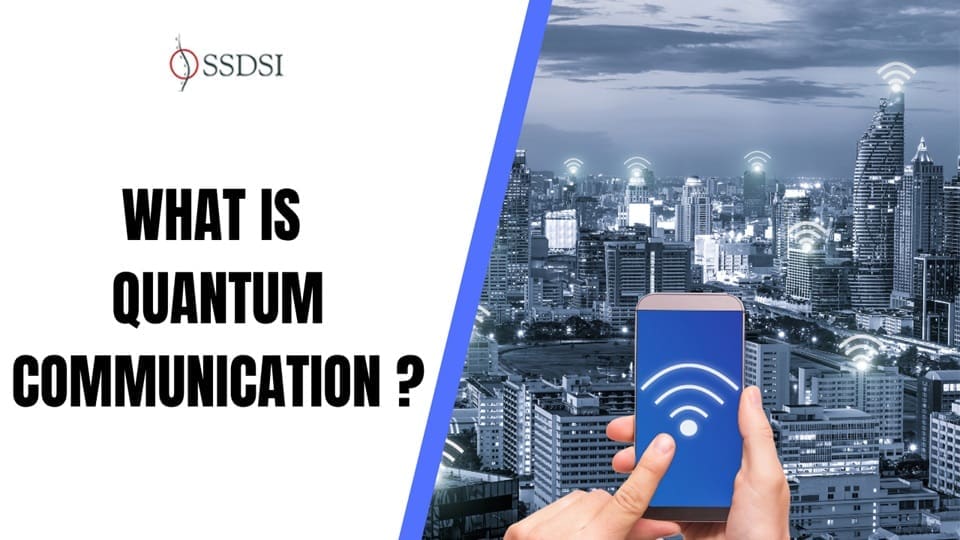Quantum communication represents a revolutionary leap forward in secure data transmission, fundamentally transforming how information travels across networks. Unlike traditional communication methods, quantum communication harnesses the peculiar properties of quantum mechanics to create virtually unbreakable security protocols.
This groundbreaking technology has captured the attention of governments, tech giants, and security experts worldwide as they race to build the quantum internet of tomorrow.
The significance of quantum communication extends far beyond theoretical physics laboratories. Today’s digital world faces increasing cybersecurity threats, making conventional encryption methods vulnerable to sophisticated attacks.
Meanwhile, quantum communication offers unprecedented security through the laws of physics themselves, creating communication channels that become mathematically impossible to intercept without detection.
Table of contents
What is Quantum Communication?
Quantum communication utilizes quantum mechanical phenomena to transmit information with absolute security guarantees. At its core, this technology leverages quantum entanglement, superposition, and the fundamental principle that measuring a quantum system inherently disturbs it. This disturbance provides immediate detection of any eavesdropping attempts, making quantum communication channels inherently secure.
The foundation of quantum communication rests on quantum key distribution (QKD), which enables two parties to share encryption keys with complete certainty that no third party has intercepted them. Furthermore, quantum communication protocols can detect even the smallest interference, ensuring that any breach attempts become immediately apparent to both sender and receiver.
Traditional communication systems rely on mathematical complexity to maintain security, creating vulnerabilities as computational power increases. However, quantum communication technology derives its security from quantum physics laws, providing protection that remains constant regardless of technological advancement.
| Aspect | Classical Communication | Quantum Communication |
| Security Basis | Mathematical complexity | Laws of physics |
| Vulnerability | Computational advances | Theoretically immune |
| Eavesdropping Detection | Software-based monitoring | Automatic quantum disturbance |
| Key Distribution | Public key cryptography | Quantum key distribution |
| Future-Proof | Vulnerable to quantum computers | Secure against all attacks |
Public, Onsite, Virtual, and Online Six Sigma Certification Training!
- We are accredited by the IASSC.
- Live Public Training at 52 Sites.
- Live Virtual Training.
- Onsite Training (at your organization).
- Interactive Online (self-paced) training,
Understanding Quantum Networks and Quantum Networking
Quantum networks form the backbone of quantum communication systems, connecting multiple quantum devices across various distances. These networks differ significantly from classical networks because they must preserve delicate quantum states throughout transmission. Quantum networking requires specialized infrastructure, including quantum repeaters, quantum memories, and sophisticated error correction systems.
Key Components of Quantum Networks

Quantum networks integrate several critical components working together seamlessly:
- Quantum Nodes: Connection points where quantum information gets processed, stored, or redirected
- Quantum Memories: Storage devices that maintain quantum states for extended periods, enabling network synchronization
- Quantum Channels: Physical pathways (fiber optic cables or free-space optical links) for quantum information transmission
- Quantum Repeaters: Devices that extend communication range by refreshing quantum signals without destroying quantum properties
- Classical Control Systems: Traditional networks that coordinate quantum operations and facilitate protocols
- Security Monitoring: Continuous surveillance systems that detect quantum state disturbances.
| Component | Function | Key Challenge | Current Status |
| Quantum Nodes | Information processing hub | Maintaining coherence | Commercially available |
| Quantum Memory | State storage | Long coherence times | Research stage |
| Quantum Channels | Information transmission | Loss minimization | Deployed in networks |
| Quantum Repeaters | Range extension | Error correction | Early development |
| Classical Control | Network coordination | Synchronization | Mature technology |
Current Quantum Network Implementations
Several countries have successfully deployed quantum networks for secure communications:
China’s Quantum Leadership:
- Developed 4,600+ kilometer integrated quantum communication network
- Combines terrestrial fiber optic cables with satellite-based quantum key distribution
- Connects major cities through secure quantum channels
- Serves government and military communications with unprecedented security
European Quantum Initiatives:
- Focus on connecting research institutions and government facilities
- Serve as testbeds for standardized quantum networking protocols
- Demonstrate real-world quantum communication applications
- Emphasize collaborative research across multiple countries
Commercial Quantum Networks:
- Emerging in financial sectors for competitive advantages
- Banks adopt quantum key distribution for transaction security
- Protect sensitive customer data from sophisticated cyber attacks
- Demonstrate practical quantum communication value
| Region | Network Scale | Primary Focus | Key Achievement |
| China | 4,600+ km | National security | Largest integrated network |
| Europe | Multi-country | Research collaboration | Standardization leadership |
| United States | Limited deployment | Military applications | Advanced repeater research |
| Commercial | City-scale | Financial services | Real-world implementation |
Also Read: What is Quantum Computing Hardware?
Quantum Entanglement Communication
Quantum entanglement communication represents the most fascinating aspect of quantum information science. When particles become entangled, measuring one particle instantly affects its partner regardless of distance, creating what Einstein famously called “spooky action at a distance.” This phenomenon enables unprecedented communication capabilities that classical systems cannot replicate.
How Quantum Entanglement Enables Communication
Entangled particles share correlated properties that remain connected even when separated by vast distances. Consequently, quantum entanglement communication systems can detect any interference because disturbing one particle automatically affects its entangled partner. This creates an inherently secure communication channel where eavesdropping becomes physically impossible without detection.
Scientists generate entangled photon pairs using specialized quantum devices, then distribute these particles between communication endpoints. The receiving parties can then use these entangled particles to establish secure communication channels and detect any unauthorized access attempts immediately.
Recent advances in quantum entanglement communication have improved the reliability and distance capabilities of these systems. Researchers have developed methods to efficiently produce nearly perfect entangled photon pairs from quantum dot sources, significantly enhancing the practical applications of quantum entanglement for communication.
Applications of Quantum Entangled Communication
Quantum entangled communication enables various applications beyond simple secure messaging:
Quantum Teleportation Applications:
- Transfer quantum states between distant locations without physical transmission
- oundation for distributed quantum computing networks
- Enable quantum processors to share information instantly
- Support ultra-precise scientific measurements
Timing and Synchronization:
- Ultra-precise synchronization between distant clocks
- Critical for GPS and positioning systems requiring exact timing
- Military and navigation system advantages
- Enhanced measurement precision in scientific research
Scientific Research Applications:
- Coordinate measurements across multiple locations simultaneously
- Telescope arrays achieve unprecedented observation precision
- Particle physics experiments require exact synchronization
- Enable measurement precision impossible with classical coordination
| Application | Primary Benefit | Industry Impact | Implementation Timeline |
| Quantum Teleportation | Instant state transfer | Computing/Research | 2-5 years |
| Clock Synchronization | Ultra-precise timing | Navigation/Military | Currently deployed |
| Scientific Coordination | Enhanced precision | Research/Academia | Ongoing development |
| Secure Banking | Unbreakable transactions | Financial Services | 1-3 years |
| Medical Data Protection | Patient privacy | Healthcare | 3-5 years |
The Quantum Internet
The quantum internet represents the ultimate goal of quantum networking research, envisioning a global network where quantum devices can communicate securely and efficiently. Unlike today’s classical internet, the quantum internet will enable applications impossible with conventional technology, including distributed quantum computing, unhackable communication networks, and enhanced scientific collaboration.
What is the Quantum Internet?
The quantum internet extends quantum networking principles to create a worldwide communication infrastructure supporting quantum applications. This network will connect quantum computers, sensors, and communication devices through quantum channels that preserve quantum information throughout transmission.
Building the quantum internet requires solving numerous technical challenges, including developing efficient quantum repeaters, creating stable quantum memories, and establishing standardized protocols for quantum network communication. Additionally, the quantum internet must integrate with existing classical internet infrastructure to support hybrid classical-quantum applications.
Current quantum internet research focuses on creating small-scale networks that demonstrate key technologies and protocols. These experimental networks provide valuable insights into the practical requirements for scaling quantum communication to global levels.
Also Read: What is Communication Plan?
Quantum Internet vs. Classical Internet
The quantum internet differs fundamentally from classical internet architecture in several key ways:
Architectural Differences:
- Classical networks copy and amplify signals; quantum networks preserve quantum states
- Quantum networks cannot measure or clone quantum information
- Requires entirely new approaches to routing, error correction, and signal processing
- Must integrate with existing classical infrastructure for hybrid applications
Security Comparison:
- Classical internet relies on computational complexity for security
- Quantum internet derives security from quantum mechanical principles
- Quantum communications remain secure against unlimited computational resources
- Protection extends to future quantum computers breaking current encryption
Capability Differences:
- Quantum internet enables applications impossible with classical networks
- Supports quantum-distributed computing with direct quantum state sharing
- Enables unhackable communication networks and ultra-precise distributed sensing
- Provides capabilities beyond current technological limitations
| Feature | Classical Internet | Quantum Internet |
| Signal Processing | Copy and amplify | Preserve quantum states |
| Security Model | Computational complexity | Quantum mechanics |
| Routing Method | Packet switching | Quantum state routing |
| Error Correction | Classical algorithms | Quantum error correction |
| Applications | Data transmission | Quantum computing + communication |
| Scalability | Highly scalable | Limited by quantum decoherence |
Quantum Repeaters
Quantum repeaters solve one of the most significant challenges in quantum communication: extending transmission distance while preserving quantum information. Unlike classical repeaters that simply amplify signals, quantum repeaters work to overcome loss and noise in quantum channels while maintaining quantum properties.
The Challenge of Long-Distance Quantum Communication
Quantum signals cannot be amplified like classical signals because amplification requires measurement, which destroys quantum states. Consequently, quantum communication range becomes limited by photon loss in transmission media, typically restricting fiber optic quantum communication to distances under 100 kilometers without specialized equipment.
Quantum repeaters address this limitation by dividing long-distance quantum channels into shorter segments connected by quantum memory devices. These devices store quantum states temporarily, allowing synchronization between network segments without destroying quantum information.
How Quantum Repeaters Work
Quantum repeaters operate by establishing entanglement between adjacent network segments, then using entanglement swapping to create end-to-end quantum connections. This process requires sophisticated quantum memories capable of storing quantum states for extended periods while maintaining coherence.
Current quantum repeater research focuses on different approaches and architectures, with significant progress in experimental implementations. However, practical quantum repeaters remain challenging to build due to the complex requirements for quantum memory performance and entanglement generation efficiency.
Modern quantum repeater designs incorporate error correction mechanisms to maintain quantum information integrity across multiple network hops. These systems must balance performance requirements with practical implementation constraints, creating engineering challenges that researchers continue to address.
Current Progress in Quantum Repeater Technology
Quantum repeater technology is rapidly progressing in research labs, though not yet at the level of widespread practical deployment:
Recent Breakthrough Areas:
- Improved quantum memory systems with longer coherence times
- More efficient entanglement generation methods and protocols
- Better error correction protocols for quantum information
- Advanced quantum state storage and retrieval mechanisms
Research Institution Progress:
- Trapped ion systems offering high-fidelity quantum operations
- Quantum dot technologies providing efficient photon generation
- Superconducting systems enabling fast quantum processing
- Hybrid approaches combining multiple quantum technologies
Commercial Development Focus:
- Integration compatibility with existing fiber optic networks
- Cost-effective manufacturing for widespread deployment
- Standardized interfaces for multi-vendor interoperability
- Scalable architectures supporting network growth
| Technology | Advantages | Challenges | Commercial Readiness |
| Trapped Ions | High fidelity | Slow operation speed | 5-10 years |
| Quantum Dots | Efficient photons | Temperature requirements | 3-5 years |
| Superconducting | Fast processing | Cooling requirements | 3-7 years |
| Atomic Ensembles | Room temperature | Lower fidelity | 7-10 years |
Global Quantum Communication Initiatives
Nations worldwide recognize quantum communication’s strategic importance and have launched significant initiatives to develop this technology. These programs drive research, infrastructure development, and commercial applications while establishing national quantum communication capabilities.
China’s Quantum Communication Leadership
China has emerged as a global leader in quantum communication deployment, developing extensive quantum networks and achieving significant milestones:
Major Achievements:
- Successfully demonstrated satellite-based quantum key distribution
- Developed ground-based quantum networks connecting major cities
- reated hybrid classical-quantum communication systems
- Established world’s largest integrated quantum communication network
Network Infrastructure:
- Connects major cities through secure quantum channels
- Provides government and military communications with unprecedented security
- Serves as proof-of-concept for large-scale quantum communication deployment
- Demonstrates practical feasibility of quantum networking technology
Investment and Development:
- Significant funding allocated to quantum repeater development .
- Satellite-based quantum communication research and deployment
- Quantum internet infrastructure development programs
- Positioning at forefront of quantum communication technology
| Chinese Initiative | Scale | Purpose | Status |
| Beijing-Shanghai Network | 2,000+ km | Government communications | Operational |
| Quantum Satellite (Micius) | Global coverage | Space-based QKD | Active |
| Urban Quantum Networks | Multiple cities | Commercial applications | Expanding |
| Military Quantum Systems | Classified | Defense communications | Deployed |
International Quantum Communication Research
European Quantum Initiatives:
- Quantum Flagship program coordinates technology development across Europe
- Collaborative research and standardization efforts across multiple countries
- Significant investments in quantum communication infrastructure and research
- Focus on interoperability and commercial applications
United States Quantum Programs:
- Emphasis on military and national security applications
- Development of quantum-secured communication networks for government
- Leading quantum repeater technology research and development
- Integration with existing defense communication systems
Global Collaboration Benefits:
- Accelerates technology development through shared research
- Addresses international standardization needs for interoperability
- Ensures quantum communication systems work across borders
- Facilitates knowledge sharing and best practice development
Practical Applications and Use Cases
Quantum communication technology finds applications across various sectors where security, privacy, and reliability are paramount. Financial institutions, government agencies, healthcare systems, and critical infrastructure operators increasingly recognize quantum communication’s value for protecting sensitive information.
Financial Services and Banking
Banks and financial institutions adopt quantum key distribution to secure high-value transactions and protect customer data. Quantum communication provides mathematically proven security for financial networks, protecting against both current and future cyber threats.
Trading systems utilize quantum communication to secure market data transmission and prevent unauthorized access to sensitive financial information. The instantaneous detection of eavesdropping attempts makes quantum communication particularly valuable for high-frequency trading applications where data integrity is crucial.
International financial networks leverage quantum communication to secure cross-border transactions and protect against sophisticated cyber attacks targeting financial infrastructure. This technology provides banks with competitive advantages through enhanced security and customer trust.
Government and Military Communications
Government agencies adopt quantum communication for classified information transmission, diplomatic communications, and national security applications. The unhackable nature of quantum channels makes them ideal for protecting state secrets and sensitive government communications.
Military quantum communication networks enable secure battlefield communications, command and control systems, and intelligence sharing between allied forces. These systems provide tactical advantages through guaranteed secure communications even in hostile environments.
Critical infrastructure protection utilizes quantum communication to secure power grids, water systems, and transportation networks against cyber attacks. Government investment in quantum communication infrastructure enhances national security and protects essential services.
Healthcare and Medical Data Security
Healthcare organizations implement quantum communication to protect patient privacy and secure medical records transmission. The growing digitization of healthcare creates vulnerabilities that quantum communication can address effectively.
Medical research collaborations use quantum communication to share sensitive patient data securely between institutions while maintaining strict privacy protections. This capability enables large-scale medical research while protecting individual privacy rights.
Telemedicine applications benefit from quantum communication security, ensuring patient consultations and medical data remain completely private and secure from unauthorized access.
Technical Challenges and Future Developments
Quantum communication faces several technical challenges that researchers actively work to overcome. These challenges include improving quantum memory systems, developing efficient quantum repeaters, and creating cost-effective quantum communication devices for widespread deployment.
Current Technical Limitations
Quantum communication systems currently face distance limitations due to photon loss in transmission media and the lack of practical quantum repeaters. These limitations restrict quantum communication to shorter distances or require expensive specialized equipment for longer range applications.
Error rates in quantum communication systems remain higher than classical systems, requiring sophisticated error correction mechanisms that add complexity and cost. Improving quantum communication reliability while maintaining security properties presents ongoing technical challenges.
Integration with existing classical communication infrastructure requires developing hybrid systems that can operate efficiently alongside conventional networks. This integration challenge affects the practical deployment of quantum communication in real-world environments.
Emerging Solutions and Innovations
Researchers develop new quantum memory technologies that can store quantum states for longer periods with higher fidelity. These advances enable more efficient quantum repeater designs and extend quantum communication capabilities.
Novel quantum error correction methods reduce error rates while maintaining communication speed and efficiency. These improvements make quantum communication more practical for everyday applications and reduce system complexity.
Advanced quantum device manufacturing techniques lower costs and improve performance, making quantum communication more accessible for commercial applications. These developments accelerate quantum communication adoption across various industries.
Future Outlook for Quantum Communication
The quantum communications market is predicted to grow significantly, with a CAGR of 28%, indicating strong commercial interest and investment in this technology. This growth reflects increasing recognition of quantum communication’s strategic importance and practical value.
Future quantum communication systems will integrate with artificial intelligence and machine learning to optimize network performance and security protocols. These intelligent quantum networks will adapt automatically to changing conditions and threats.
Standardization efforts will establish interoperable quantum communication protocols, enabling seamless integration between different vendors’ equipment and facilitating global quantum communication networks.
Implementation Strategies for Organizations
Organizations considering quantum communication implementation should develop comprehensive strategies addressing technical requirements, cost considerations, and integration challenges. Successful quantum communication deployment requires careful planning and expertise in both quantum technologies and existing communication infrastructure.
Assessment and Planning Phase
Organizations must first assess their security requirements and identify applications where quantum communication provides significant advantages over classical alternatives. This assessment includes evaluating current security vulnerabilities, compliance requirements, and strategic objectives.
Cost-benefit analysis should consider both initial implementation costs and long-term operational expenses, including maintenance, training, and system upgrades. Organizations should also evaluate the potential costs of security breaches that quantum communication could prevent.
Technical feasibility assessment examines existing infrastructure compatibility, required modifications, and integration complexity. This evaluation helps organizations understand implementation timelines and resource requirements.
Implementation Best Practices
Phased implementation approaches reduce risk and allow organizations to gain experience with quantum communication technology gradually. Starting with pilot projects enables organizations to understand practical requirements and optimize deployment strategies.
Staff training and education ensure successful quantum communication deployment and operation. Organizations must invest in developing quantum technology expertise among their technical teams and security personnel.
Vendor selection criteria should emphasize proven experience, ongoing support capabilities, and compatibility with existing systems. Organizations should also consider vendor roadmaps and long-term viability in the rapidly evolving quantum technology market.
Integration with Existing Systems
Hybrid classical-quantum systems enable organizations to leverage quantum communication benefits while maintaining compatibility with existing infrastructure. These systems provide migration pathways that minimize disruption and reduce implementation risks.
Security protocol integration ensures quantum communication systems work effectively with existing security frameworks and compliance requirements. Organizations must adapt their security policies and procedures to accommodate quantum communication capabilities.
Performance monitoring and optimization ensure quantum communication systems deliver expected benefits while maintaining operational efficiency. Organizations should establish metrics and monitoring systems to track quantum communication performance and security effectiveness.
Frequently Asked Questions on Quantum Communication
What is quantum communication and how does it work?
Quantum communication is a revolutionary technology that uses quantum mechanical properties like entanglement and superposition to transmit information with unprecedented security. It works by encoding information in quantum states of particles (usually photons), which cannot be measured or copied without disturbing the quantum system, thereby detecting any eavesdropping attempts.
Is quantum communication really unbreakable?
Quantum communication provides theoretically unbreakable security based on the laws of physics rather than mathematical complexity. Any attempt to intercept quantum information disturbs the quantum states, immediately alerting both sender and receiver to the security breach. However, practical implementations may have vulnerabilities in the classical components of the system.
What is the difference between quantum networks and classical networks?
Quantum networks preserve quantum information throughout transmission, enabling applications impossible with classical networks. Unlike classical networks that copy and amplify signals, quantum networks must maintain quantum states without measurement. This enables ultra-secure communication, distributed quantum computing, and enhanced sensing capabilities.
How far can quantum communication work?
Current quantum communication systems work effectively over distances up to 100 kilometers through fiber optic cables without repeaters. Satellite-based quantum communication can work over much longer distances, with demonstrations spanning thousands of kilometers. Quantum repeaters under development will enable unlimited range quantum communication networks.
Final Words
Quantum communication represents a paradigm shift in secure information transmission, offering unprecedented security through the fundamental laws of physics. As organizations worldwide face increasing cyber threats, quantum communication provides robust protection that remains effective even against future quantum computers capable of breaking current encryption methods.
The journey toward widespread quantum communication adoption continues accelerating, with significant progress in quantum networks, quantum repeaters, and practical applications. While technical challenges remain, ongoing research and development efforts steadily overcome these obstacles, bringing practical quantum communication systems closer to reality.

About Six Sigma Development Solutions, Inc.
Six Sigma Development Solutions, Inc. offers onsite, public, and virtual Lean Six Sigma certification training. We are an Accredited Training Organization by the IASSC (International Association of Six Sigma Certification). We offer Lean Six Sigma Green Belt, Black Belt, and Yellow Belt, as well as LEAN certifications.
Book a Call and Let us know how we can help meet your training needs.




















